East Europe 2022: Croatia, Montenegro, Bosnia, Slovenia & Hungary
Like most people, I was feeling cooped up in the US, especially with daily devastating news of mass shootings and vitriolic discordant politics. But I couldn’t leave until my new passport arrived. When it did, I scoured the Overseas Adventure Travel (OAT) website for the first available spot for a single traveler to an interesting destination. I almost never travel with a tour company, but with Covid still prevalent, I thought it would be safer as the company may have arrangements to help me if I got sick. A couple of people had suggested OAT because it catered to small groups and did not levy a supplement for a single traveler.
The “Crossroads of the Adriatic” came up as the most interesting tour with an opening in mid-June. These countries were a part of former Yugoslavia (land of the Southern Slavs) that splintered in the early 1990s. I had traveled through the region in 1962 when I was a student in England on a road trip from London to Athens. At the time, Yugoslavia was ruled by Marshall Tito who, with Prime Minister Nehru of India, led the Non-Aligned group of counties during the Cold War, a stance I agreed with.
I experienced the dissolution of Yugoslavia through colleagues at the World Bank, where I worked for many years. One colleague’s family was trapped in Sarajevo during the four years long siege of that city. Other colleagues, by then citizens of Slovenia and Serbia, had personal stories about that period, too. Intrigued by these connections, I read Nobel Laureate Ivo Andric’s books, “The Bridge on the Drina” and “Bosnian Chronicle”. I also browsed Rebecca West’s travel tome “Black Lamb and Grey Falcon” before the trip.
I added Budapest at the end of the tour as I had arranged to meet an old friend who offered to show me around. I have been curious about Hungary since I got to know fellow students in England who had escaped during the 1956 revolution against the Soviet dominated repressive regime. I bookended my trip with a few days in London to visit friends and get a dose of metropolitan culture in a familiar language.
The East European countries I visited have melded multiple cultures starting from Ancient Greece, and Persian, Roman, Byzantine, Ottoman, Venetian, Austro-Hungarian, and Napoleonic Empires. Because of all these influences, the region’s history is complicated. In relatively modern times, Ottoman rule was the longest, for about four centuries. It was linguistically, ethnically, and religiously diverse and tolerant: several religions, Orthodox, Catholic, and Protestant Christians and Islam vied for the population’s allegiance, and Judaism was practiced as well.
The tour lasted 17 days, starting in Dubrovnik in Croatia, wending in and out of that country to visit Kotor in Montenegro, Mostar and Sarajevo in Bosnia & Herzegovina, back to Karnac, Zagreb and Opatija in Croatia, and ended in Ljubljana in Slovenia. We were accompanied by a tour guide throughout, supplemented by local guides in every city to orient us on walking tours of cities, and other locals to tell us about their experience during the 1990s war of independence. We were nine in the group, six from the San Francisco Bay area, and all about the same age, except for one recent high school graduate traveling with her grandmother.
To make it easier to follow, I will relate the journey by country rather than by route.
Croatia: Dubrovnik is a beautiful medieval town on a small peninsula in the Adriatic Sea. It was founded in the 7th Century as a protectorate of the Byzantine Empire and, with periods as an independent maritime state, it has come under the rule of Venice, Hungary-Croatian Kingdom, Napoleonic Empire, Austro-Hungarian Empire and Yugoslavia, and is now a part of Croatia.

The fortified old town was besieged and damaged during the War of Independence, and rebuilt to its former glory with UNESCO’s assistance. It is now a tourist town with small museums, restaurants, bars and shops. Walking through its narrow streets, lined with limestone brick buildings with red roofs, feels like being in a movie set.
A boat trip to the nearby Lokrum Island, and a demanding hike up to the Napoleonic Forte Royale, yielded a stunning view of the old town from the distance. Back in town, the hour and a half walk along the City Wall was taxing on a hot day, but rewarding for the views of the city and the clear blue sea. Afterwards, we relished the wine tasting session at D’Vino where a flight of good white and red wines, accompanied with lots of local cheese and hummus relieved some of the physical stress. My fellow tourers, Steve & Barbara were professional wine-tasters, swilled wine in the glass for its fragrance and in their mouths for its taste. I was happy to just drink.

Dubrovnik Port
On another day, after visiting the War Museum on a hill above the town, where we heard the wrenching story of a survivor of the city’s siege during the war, the view of the town below provided relief. I had lunch at Nishita, a vegetarian restaurant recommended by a neighbor who had a spent a year in Dubrovnik. My tofu and vegetables with noodles dish was bland, but my taste buds came alive after I laced it with chili sauce.
That afternoon, we drove to a farm away from the tourist area where the owner, a showman, regaled us with the excellence of his olive oil, which was indeed good, but the meal and wine he served later were not. The accordion music during dinner, and the cajoled conga dance afterwards, were downright hokey.
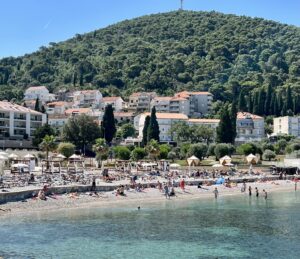
Dubrovnik: View from Kompas Hotel
There are no hotels in Dubrovnik town. Kompas, our comfortable modern hotel by the Adriatic Sea, and the best on our tour, was in Lapad, the adjoining modern city. It was at one end of a semi-circular arc of a long promenade, with hotels, restaurants, apartments and houses rising up on the hill. Our access to the sea was from the other side of the arc with step ladders down into it. The water was a clear blue, cool and lightly salted, very inviting after walking in the old town under a blazing sun. A stroll along the promenade at night was especially lovely as it was cooler, and the shore lights reflected on the water gently lapping the coast.
The tour arranged an overnight stay at a farm in Karanac in the fertile Baranja district in the north-east corner of Croatia near Hungary. As we made good time, we stopped for a while in a nearby small town, Davoko, which had a huge cathedral built by architects from Vienna. By chance a wedding party was approaching as we walked by. In their jollity, they shared some local schnapps with us as we listened to their small band while the wedding party gathered.

Karanac Sunflower Field
The longish, narrow farm was rustic, with a simple dwelling area in front, lined by storage sheds on one side and newly built rooms on the other, and animal shelters and farmland further back. After a few years of catering to OAT tours, the owners spoke English well enough to explain a fresh cheese making process to us and talk about the farm. A cousin came in the next day and engagingly demonstrated how to make pottery. As the farm owners had catered to tourists several times a year for a few years, it felt a bit staged. Still, I can hardly complain as I was awarded the gold medal for my pottery sculpture, and the morning walk through corn and sunflower fields was authentically rural.
Zagreb is the capital of Croatia and its Habsburg architecture conforms to its status. Beautifully renovated buildings and parks cover the downtown area. On the evening of our arrival there was a jazz concert in the garden of the Exhibition Hall near our hotel. On the next morning, we were taken on a walking tour to all the main sights such as the Neo-gothic cathedral, large farmer’s market, the parliament building, and museums. Later, I walked by the other main historic buildings and botanical gardens. Lovely city indeed.

National Exhibition Hall Concert
I visited the museums of naïve art, which had some unusual pieces. Near its entrance, I noticed a plaque for Nicola Tesla who worked in the area. The museum of broken relationships was, as its name implies, full of sad stories and memorabilia, hard to read too many of them. We needed the uplift of tasting good wines at Borstein’s located in a cellar, actually a 200 years old brick vaulted building. The owner, an Australian Croat, gave a lively discourse on the wines, three white and three red, and they were flavorful, but had hard to remember names. For this tasting, John, who had made wine in California, and his wife Janine, joined Steve, Barbara and me.

Marshall Tito by Augustincic
We drove out of Zagreb to the gallery of a famous sculptor, Antuna Augustincic in Klanjec, a small town where he had lived and had his home-studio. His major work is displayed outside the UN building in New York. A guide explained his sculptures, which were shown in his house and garden. It was a small version of the Rodin Museum, whom Augustincic admired. He was also a friend of Marshall Tito whose statue had a prominent place in the garden. We drove further to Tito’s village, Kumrovec, not far away. Actually, it was a rebuilt village made into a museum. A guide walked us through it, explaining life there during Tito’s time, and filled in some details of the leader’s young years. Close to Slovenian border, the countryside was lush green with undulating hills and fields planted to corn and vines among other produce. We stopped for lunch at a rustic restaurant with a gorgeous view of a castle on a hill. My mushroom soup and vegetable risotto were pretty good.

View from Kumrovec
After we got back to Zagreb at about 4:30 pm, we went to see the Mirogoj Cemetary, the resting place of many of Croatia’s intellectuals and artists. It is a vast area damaged in a recent earthquake. We walked around the memorials, some remarkable, in intense heat and humidity, which diminished our attention. For relief, we again turned to tasting wine at “Time 4 Wine”, the Chardonnay and Traminer were pretty good, but the Cabernet and Syrah that followed, were young with muted flavors.
The next day entailed a long drive towards Opatija with a stop at Plitvice Lakes, sixteen of them linked by waterfalls and cascades in 114 square miles, the largest national park in Croatia and a UNESCO World Heritage site. With a local guide, we ambled along the wood and dirt path for visitors by the clear turquoise lakes to take in the views while leaving the flora, fauna, and wildlife undisturbed.

Plitvice Lakes
After a few hours drive, we reached the Adriatic and drove along it for an hour and a half to Opatija. A resort town of yore, with grand villas and elegant facades, some of them updated. Our hotel was an older building adjacent to the botanical gardens and a short walk down to the beach. The sea was warmer than in Dubrovnik, but a little choppier. The promenade stretched for a couple of miles in each direction to other resort towns. After almost daily long bus rides, I was happy to be still, walk around the town and swim. I had been hunting for a good “black risotto”, a recommended specialty of the region, and had tried a couple, but not found them particularly exciting. At Roku, a restaurant near the hotel, the seafood risotto enhanced by the nuttiness of truffles, satisfied my curiosity.
The tour arranged a day excursion from Dubrovnik to Kotor in Montenegro. A small hilly country as its name implies, and the only one in the area to avoid Ottoman rule. After the bus ride, made longer by a border crossing, we stopped at a village to board the boat that took us on clear blue Kotor Lake, past a small island with a church built in 1630, to the town with the same name, a medieval city and a UNESCO World Heritage site.
Smaller than Dubrovnik, its narrow, cobbled stone streets, an obstacle for large armed invasions, led to mansions, houses, churches and squares. But like Dubrovnik, it has gone over entirely to tourism. A local guide walked us through the town and informed us of its history. When that was done, we lunched in a restaurant known to serve Kotor’s renowned mussels, which were plump and salty, moderated by the light wine sauce.
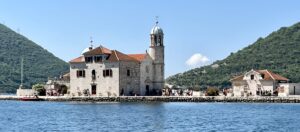
Island on Kotor Bay
I had intended to walk through the town again and climb steps to a high point to get a better view, but just as I got to the main square, a huge Viking tour ship docked in the deep natural harbor disgorged hundreds of tourists, making it difficult to manage the narrow streets and steps. On our way back, as our bus climbed up the hills, I noticed the bay was surrounded by a necklace of small villages with whitish houses and red roofs, and a church spire reaching higher.
After finally leaving Dubrovnik, we traveled towards Sarajevo in Bosnia & Herzegovina with a stop in Mostar for lunch. As we got closer, our guide briefly related the history of Bosnia. The main difference from the other countries in our tour is that 40 percent Bosnia’s population follows Islam and that is reflected in their dress, food, and architecture of buildings and markets. She also mentioned the bridge across the Neretva River, Stari Most, and the town that was named after it. She said that the iconic bridge had been destroyed during the war, when Yugoslavia splintered into several countries, and was rebuilt in 2004 with a loan from the World Bank. That got my attention because, being a policy person, I had never seen a physical project funded by the Bank.
We arrived at Mostar at about noon, and were let off our tour bus near the old town. It was as hot as hell. We were led through a narrow bazaar lane, paved with small stones. I had to concentrate to keep from twisting my ankle, but caught glimpses of the tourist shops and food stalls on both sides. Our restaurant was close to the bridge’s entrance. I was shown steps down to the river to get good photos. I walked down to the pebbly bank where several young people were sitting, taking in the sun, eating their lunch, and some were swimming.

Mostar Bridge
With a modern eye, the bridge does not seem exceptional. Suleiman the Magnificent commissioned Hayruddin to build it under the pain of death in 1557. Not confident that it would stand, he prepared his funeral as the scaffolding was being dismantled. It was then the longest man-made arch, and an outstanding example of Balkan Islamic architecture.
After lunch, I walked the span of the bridge. The stones were polished smooth to a dull white by wear, and slippery, especially on the downslope. Our tour guide warned us that a woman on a previous tour was injured there and had to cut short her trip. With that in mind perhaps, there were slightly higher cross layers of stones every couple of feet to keep people from sliding. Shops lined the other side of the bridge for another half mile until a normal city street with a mosque came into view.
In my wandering, I found a small art gallery with abstract art, the only store not selling tourist kitsch. A lady in a black burqa greeted me. She told me the artist was her husband. He came in a few minutes later, a burly man in his 40s sporting a full beard. He immediately noticed the small MOMA (museum of modern art) on the side of my baseball cap rather than the big NY Yankee logo in front. I asked if he had visited the museum. He replied that he had not, but it was his dream to go there. I liked his work and bought a painting.
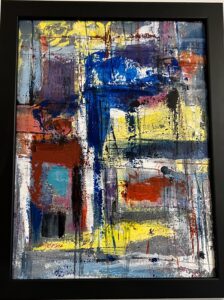
Painting from Mostar
The bridge was destroyed during the recent war by a Croatian General, which our Croatian tour guide omitted to mention, and rebuilt in 2004 under the aegis of a UNESCO-established scientific committee, and funding from several sources including the World Bank. Divers searched for the original stones and supplemented them from a nearby quarry. Hungarian and Spanish army engineers cooperated to rebuild it and, among other dignitaries, the president of the World Bank attended the opening ceremony.
The bridge now has another use. People jump off it into the river, some for 50 Euros. It has become an annual competition in diving organized every year at the end of July. Young men of the town leap from the bridge into the Neretva. As the river is very cold, this is a risky feat and requires skill and training.
We reached Sarajevo late in the afternoon. Our hotel was by the Miljacka River, about the mile from the heart of the old town. The closer river bank had a path used by walkers, joggers and bikers, and several bridges over it connected to roads leading to the old town and market. The main road through the market ended at Pigeon Square near Sarajevo’s City Hall, a pseudo-Moorish building with decorated vaulted ceiling inside. It was damaged during the siege and slowly restored with support from the EC and several European countries. Along the way though, the architecture is a curious mixture of Hapsburg-Austria and Turkish-Ottoman.
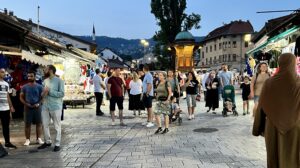
Pigeon Square
The walking tour of the old city next morning emphasized religious tolerance: we visited a Roman Catholic Cathedral, Orthodox Christian Church, Jewish Temple and the main Mosque. We also stopped at the spot where Duke Ferdinand was killed, triggering the First World War. Later in the afternoon, I hunted down the National Art Gallery of Bosnia Herzegovina. The special exhibit was colorful and flamboyant, but the permanent collection had paintings that were realistic and mostly dark.
Our tour emphasized the 1990s war of independence, especially in Bosnia: the siege of Sarajevo lasted for four years, and the suffering inflicted on the population was far worse than in Dubrovnik. A survivor of the war told us of his awful experience. The next morning, we drove to the “Tunnel Museum”, learned more about the siege and the tunnel’s role in supplying Sarajevo during those years. The tour had also arranged a dinner for us in the home of a “normal” family living in a socialist style boxy apartment building. We dined with a grandmother and her daughter in law, who worked as a cashier in a supermarket. The grandmother made the meal and the daughter-in-law told us about surviving the siege, and later bringing up children in independent Bosnia. The apartment building was in “sniper alley” during the war, when our hosts had to sometimes dodge bullets to get food or go to school.
After hearing so much about the tragic war, it was difficult to pluck up the courage to visit the gallery and museum documenting war atrocities, especially the massacre at Srebrenica.
Slovenia: On the way to Ljubljana we stopped at the Postojna caves, considered a masterpiece of nature. It is an amazing underground journey in a toy train to see fantastic limestone formations, some huge stalagmites, and even an underground concert hall.
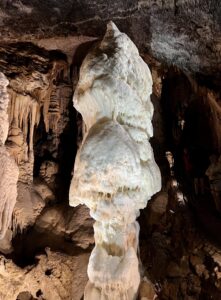
Postojna Cave
We reached Ljubljana just after 4 pm, held up by a traffic jam for a while. We got a guided walking tour of the old town to get oriented. The main square, situated by the Ljubljanica River, had beautiful old buildings and statues. The river was lined with restaurants and cafes on both banks. A hill rose behind the square with a castle on top. As we arrived on a Friday, there was a regular food fair with stalls offering cuisine from all over the world and local wine as well. I tried some Paella, which was not great, but the local wine was good. The city has a visibly young population because of its large university that makes it lively.
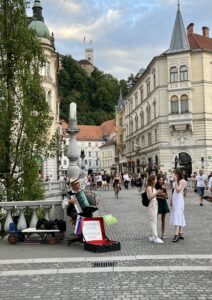
Ljubljana
The next morning, we drove to Lake Bled, another beautiful clear blue lake with an island in the middle. We took a gondola ride to the island and rang the church bell, which apparently helps to fulfill wishes. Afterwards, we drove to the castle on top of a hill. Its museum had some historical artifacts, but the view of the lake and its surroundings was spectacular. We lunched at Avgustin restaurant in a small cute village, Radovljica.
Back in Ljubljana, I took a circle tour of the town on a small trolly-train that went by the castle, residential neighborhoods, botanical gardens, past parliament, the national museums and galleries, many with adjacent parks. Graceful town. I mentioned this to a former colleague who has retired there, and he concurred. He added that it was also close to so many other places in Europe if he wanted a cosmopolitan experience. Later, I drank some decent wine with my tour’s wine couple, Steve and Barbara, at Wine Bar Suklje, a good Sauvignon Blanc to wash down plump, silky oysters, the best I have ever eaten.
The next morning’s boat ride along the Ljubljanica River was pleasant, especially with the glass of Prosecco. After it docked, I walked to the Ethnographic Museum, a modern building with a good display, but not so interesting for me as I had read about the Balkans. The Contemporary Art Museum next door, was a new building with displays of media and objects that were too way out for me. The National Gallery, a Habsburg style building with a modern annex, had paintings and sculptures that depicted war or religion. The annex had more interesting paintings with modern influences. The Modern Art Museum nearby had abstract paintings that appealed to me more.
At about 6 pm the group met for a farewell drink and a jolly, amiable dinner at a restaurant nearby. The experienced tour members thought that our small group was among the best they had traveled with, congenial and flexible. Our tour leader was particularly enthusiastic, empathetic and well-informed, which made the trip more interesting. Would I join a tour again? Probably, but as usual there are pluses and minuses. That all our transport and lodging were arranged was really great, and the tour company’s literature and the guided walking tours in every city were helpful. I certainly saw and did more than I would have on my own. However, I felt that we were too programed, left with little time to just amble and experience the places we visited. Even when we had free time, we tended to join other members of the tour group to wander around, which diminished the chance of meeting and talking to locals, a good way to get a flavor for life in a city, and probably better than the formal meetings arranged by the tour.
Hungary: Passengers scrambled on to the air-conditioned Flix bus in Ljubljana to get out of the searing heat. It was a six-hour ride to Budapest (hilly Buda on the west side of the Danube River and flat Pest on the east). As the wifi was not working, I had nothing to read. My seat had been arbitrarily changed to one where a window frame gave me a partial view of the landscape. To make matters worse, a young, overactive girl in the seat behind could not sit still or quietly.
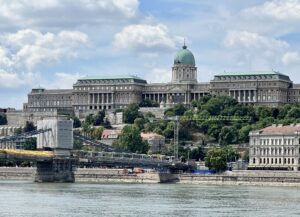
Buda Castle
The landscape, as much as I could see it, was flat with fields planted mainly to corn, some vines, sunflowers and other vegetables that I did not recognize. We passed small villages along the way, and occasionally a small town identified by a church spire. We hugged Lake Balaton for about an hour. My hotel was in Pest not too far from the Danube River and about a mile from the striking Parliament building. The immediate neighborhood had coffee shops, restaurants with food from all over the world, and good transport connections.
On the next morning, I met Diana, whom I knew well in the early 1960s, at her boutique hotel nearly at the top of the hill near Buda castle. Although she lives in Brussels, she has a residence not far from Budapest where she spends the summer months. She had kindly agreed to meet me in the city and show me around it for a few days. We had lunch at her hotel: I tried the Goulash soup, but it was thinner and less spicy than I imagined, and there was no dry Tokay wine available, but the red Bikaver paired well.

Parliament
After lunch we walked up the hill to Matthias’s Church, reconstructed in the 14th Century in the Gothic style, past Trinity Square to Fisherman’s Bastion to get a view of the magnificent Parliament building in Pest. We walked around the majestic Buda castle and visited the National Art Gallery and an Art Deco show in the castle complex. The National Gallery’s collection was mainly of Hungarian artists from the 19 th. and 20 th. Centuries, several influenced by European artists of their time, and there were some contemporary post-World War II works as well. The Hungarian Art Deco exhibit emphasized art and the urban lifestyle between the two world wars, including posters, furniture, fashion garments, and films and other new forms of entertainment. After many hours of walking, we found a tourist restaurant nearby where I had a hearty fish goulash soup with some light white wine, leaving my quest to taste a Tokay unfulfilled.
Next morning, I walked down to the Parliament to meet Diana, but we had to wait for about an hour for a tour. To while away the time, we walked along the Danube across from the castle. On the way back, we chanced upon a memorial, a row of iron shoes at the bank of the river, to commemorate the 3500 people, including 800 jews, shot there in 1944-45 by the Arrow Cross, a Hungarian ultra-right-wing party. A gathering of Jews was singing in payer as we passed. The tour of parliament, a striking neo-Gothic exterior and beautifully decorated-interior, was well organized and informative and lasted about an hour. Afterwards, we ambled down small streets lined by restaurants and shops to Gerbaud Cafe, a restaurant Diana remembered. The food was pretty good although the service was slow.

Parliament at night
We took a metro ride to the Square of Heroes and lined up for an hour to get into the Museum of Fine Arts. Once in, we walked through exhibitions of Matisse’s and Heironymus Bosche’s work. About a hundred of Matisse’s colorful paintings, graphic sheets, prints and sculptures were on display, on loan from the Centre Pompidou. Hieronymus Bosch’s unusual and original art treats difficult subjects such as virtue and vice, faith and truth, and spirituality.

Bosch: Garden of Earthly Delights
Afterwards, we walked down Andrassy, a main boulevard with many stately mansions on both sides with decorative facades and, after many twists and turns, found New York Café that Diana remembered as being a nice place for a drink and rest. This stately building, in the Belle Epoch style, was the European Headquarters of New York Life Insurance Company and is now a posh hotel. The café’s vaulted ceilings were ornately painted, befitting a palace, and the piano music and service staff dressed in black gave it an appropriate formality. We enjoyed a glass of wine and chatted for an hour or more, some of it with a couple from Switzerland at the next table. The wife, an American, had attended New York University where I had been a professor a lifetime ago.
The next day, I met Diana near Gerbaud Café and walked down a long narrow street with restricted traffic lined by cafes on both sides. Being fairly early, it was not active, but interesting for what it could look like. We reached a large covered market that supposedly offered Hungarian products, probably true for the ground floor where shops had food products, but probably not for the upper floor where textiles were on sale. Knowing that they were likely made in China, I nevertheless bought gifts for my daughter and her fiance. We walked downtown near the National Museum and further to the city’s historic great synagogue, the largest in the world outside New York, and an architecturally unique structure. Later in the evening, we went on a cruise along the Danube River. It lasted about an hour and quarter, went below the final bridge across the river and round Margarite Island that has been made into a park and sports facility.

Thermal Baths
I was on my own for the final day in Budapest. I decided to ride the “get on, get off’ bus that had 20 stops around the city. It turned out that Diana had taken me on a pretty thorough tour of Budapest, but I did stop at the Parisi Café, and elegant building, and Gellert Hotel to look at the art nouveau thermal baths. In the evening, I thought to reprise my nice glass of wine at New York Café, but instead decided to be adventurous and walked to a wine bar named “Wine Not?” that I had noticed during an earlier walk. It turned out to be shop and wine bar that had a knowledgeable owner and also some elegant, dry, white Tokays with tongue twisting names.
London: I spent six days in London before joining the tour in Dubrovnik and another six days after Budapest mainly to visit old friends from the early 1960s when I was at college, but also to see some plays and exhibitions.
A friend had mentioned the British Museum’s exhibit about the history of Stonehenge. It turned out to be an interconnected social history of early Europe, from 4000 to 1000 BCE, told through objects such as metalwork, woodwork, and jewelry. The Tate Modern had an exhibit titled “Surrealism Beyond Borders”, that showed works from all over the world expressing a spirit of rebellion. The movement questioned political and social systems, conventions and dominant ideologies. Works by Joan Miro about the 1968 uprising in Paris, Picasso’s three dancers, and Younan’s abstract image from Egypt, were particularly interesting.

Joan Miro: 1968 Student Uprising
The Courtaulds Gallery had an exhibit of Munch’s work. It was not a big show, but there were some interesting pieces expressive of the artist’s depression with titles like: Anxiety, Melancholy and Death. The missing sentiment was “Scream”, his most famous painting. The gallery’s collection had several works by Gaugin and other impressionists as well. I also went to the Rafael exhibit at the National Gallery. Most of his work has a religious theme depicted in luminous colors–portraits, drawings, bas-reliefs, and tapestries. I liked the best the fresco titled “School of Athens” with Plato and Aristotle in the center. Plato’s hand is turned up to symbolize his idealism, and Aristotle’s turned down towards the ground to depict his realism. Other philosophers are shown in discussion to suggest an exchange of ideas and knowledge.
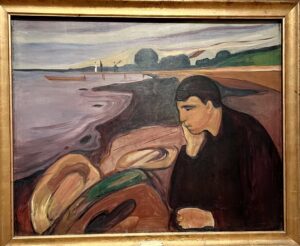
Munch: Melancholy
I saw “The father and the Assassin” at the National Theater. It was about Gandhi’s quest for a non-violent, secular, and democratic India; and Godse’s (his assassin) preference for a violent overthrow of colonial rule and a Hindu theocracy. The play was well acted, very moving, and relevant to the current Modi government’s effort to encourage a Hindu society. I also saw “Straight Line Crazy” at the Bridge Theater, in a new and interesting development by the Thames River near London Bridge, as the name suggests. The play was about Robert Moses, who rebuilt Manhattan and Long Island in a grid with streets and avenues in straight lines, using all his guile to get the project done. Ralph Fiennes was on stage for most of the two-hour play, a tour de force of excellent acting. Part way through, he noticed a person near the stage that seemed about to faint. He interrupted the play and the actors went off-stage while the person got medical attention. They came back and picked up where they had stopped as if they had not been interrupted.

Rafael: School of Athens
I walked through my alma mater, the London School of Economics, Lincoln Inn Fields to Holborn, Tottenham Court Road and along Oxford Street to Marble Arch, still the main shopping area, but with surprisingly little traffic. On another day, after visiting the National Gallery, I walked down Parliament Street, past Downing Street, to Parliament, along the river towards the East. I visited Regents Park where I found Queen Mary’s Rose Garden: although past its full bloom, it was still colorfully attractive. My main walks though were on Hampstead Heath, along its forested paths to Kenwood House, the swimming ponds by Highgate, and up to Parliament Hill for a great view of the City. I lived around the Heath for six years in my youth and still do my best thinking there.

Hampstead Ponds

